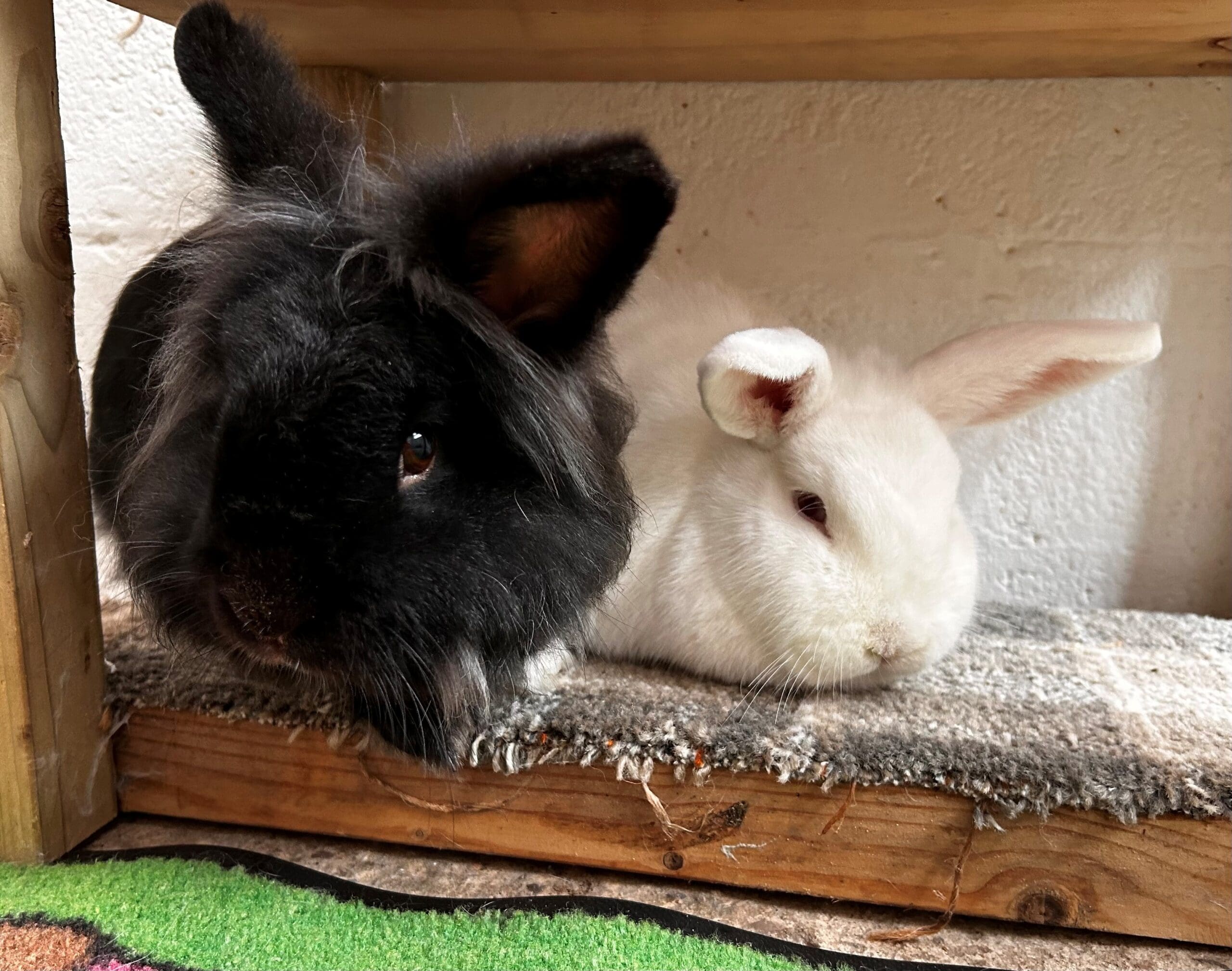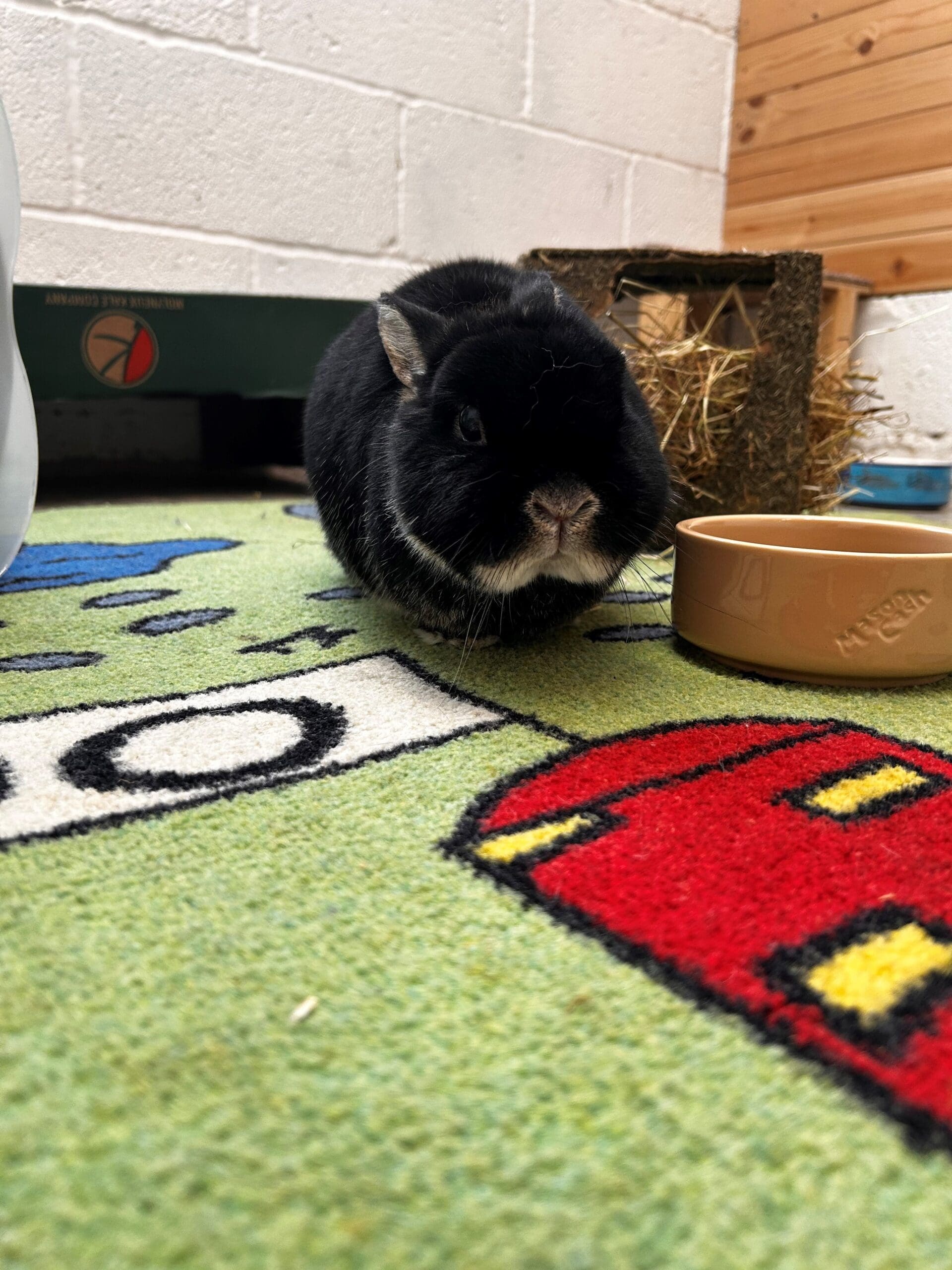Rabbit Welfare – A hutch is not enough!
Rabbits are one of the most misunderstood animals in terms of their requirements and care needed. They are often referred to as the silent sufferers.
Environment – A hutch is not enough
Providing your rabbit with an ample amount of space to stretch, run, lie down, and binky is very important. A binky is the jump and twist that rabbits love to do. There are guidelines for minimum space requirements for housing rabbits whether they live inside or out. If you can provide more space, that is even better for your rabbit’s welfare.
A hutch should be permanently attached to a larger run to ensure they can exercise freely. It’s recommended the hutch is at least 6ft x 2ft attached to a run with a total floor space of 7ft by 5ft which they have access to at all times. This allows them to move freely and explore as they would if they were a wild rabbit.
It is important to note that the space must be across a single level, so raised hutches within the space will not count towards the minimum space requirement If you can provide free-range space, that is even better, but please ensure roaming is supervised. Most importantly, the bigger the space, the more room they will have to exercise and keep in shape!
Rabbits are naturally nervous as they are prey animals, so it is important that their enclosure or housing has a safe spot that if they feel unsure, they can escape to when worried. The sleeping area should contain hay or other rabbit-friendly bedding. Away from the sleeping area, a dedicated toilet spot should be created for your rabbit. The toileting area should be lined with newspaper, straw, or a paper-based litter that doesn’t expand.
Rabbits also require enrichment in the form of tunnels and platforms so that they can perform normal behaviours that they would in the wild, such as: digging, foraging, and stretching up on their back legs or lying fully out with their whole bodies. Rabbits like to forage and you can buy a treat ball to feed them, or use cardboard from the toilet roll stuffed with hay and fresh vegetables as a tasty treat. You can also make a turf tray by filling a litter tray with turf. This is particularly good if their run is not on grass. You should spot clean your rabbit’s housing once a day – removing soiled materials and un-eaten food. Use a rabbit-safe disinfectant and then carry out a full deep clean at least once a week.
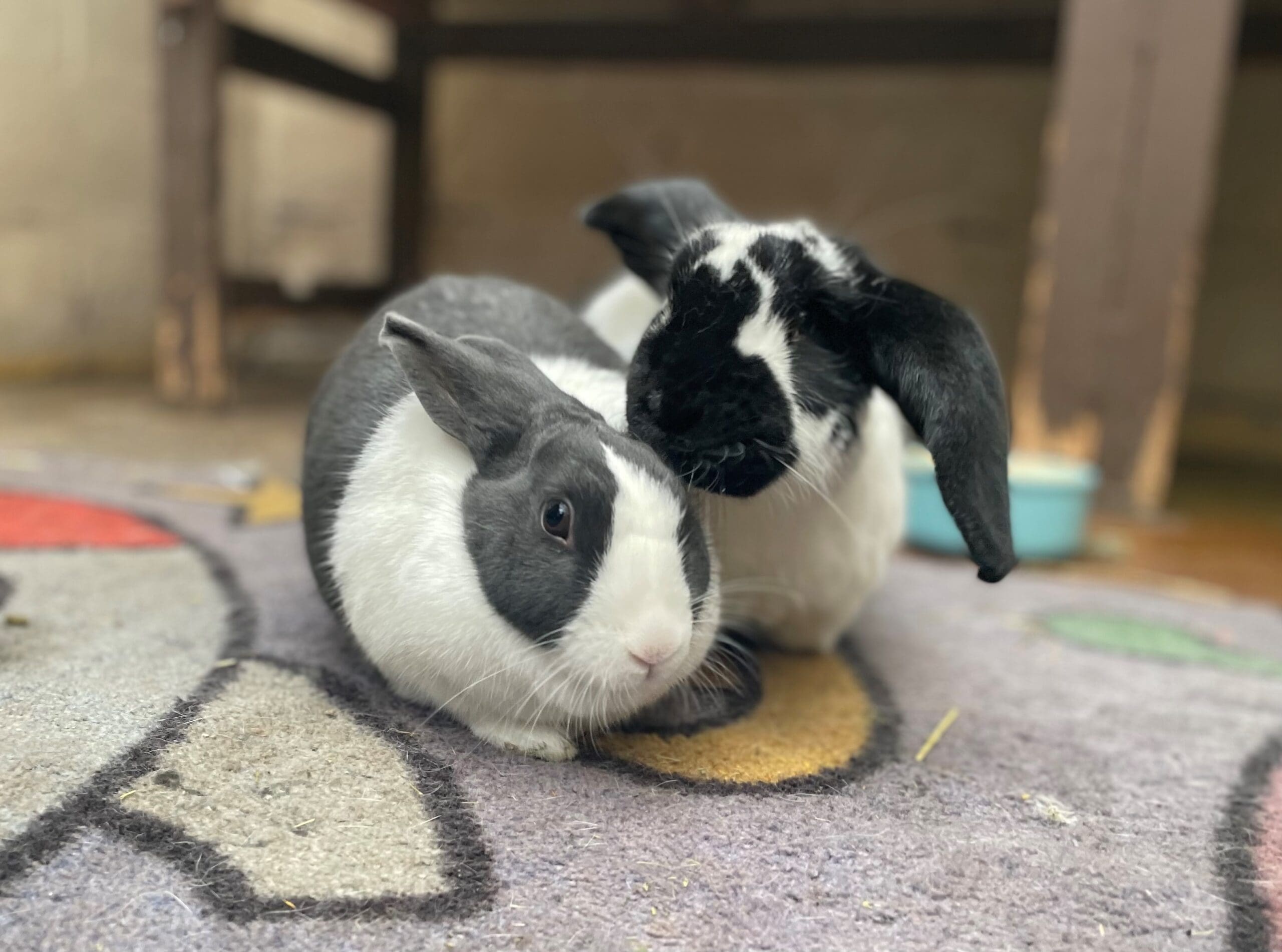
DIET –
Rabbits main food should be grass or hay, they can eat as much of this as they like. Hay is available all year round and provides them with the nutrients they require with lots of fibre, keeping your rabbit’s digestive system moving, and it is the closest thing to a natural diet. Complete rabbit food is also available but should not be a replacement for hay, we recommend only giving a small handful per rabbit per day. There are many vegetables that rabbits love including kale, broccoli, parsley, spring greens, pea-shoots, celery, baby corn and carrots. However, you should also keep the portion sizes to a handful a day. Fruit should be counted as a treat for your rabbit as it is high in sugar. You should ensure that your rabbit always has access to fresh, clean drinking water.
Obesity is a huge problem in pet rabbits. Two of the main causes are insufficient exercise and a poor diet with too many high sugar treats. Obese rabbits suffer from several health issues. These include putting extra strain on their joints and not being able to clean themselves properly, which puts them at greater risk of other deceases too.
HEALTH – Rabbits hide pain and illness well.
To keep your rabbit fit and healthy, you can regularly check
Eyes: Ensure they are clear, shiny, and free from discharge
Ears: Ensure they are free from discharge and no mites are present
Mouth: Ensure it is free from drooling and there is no swelling
Skin and coat: Ensure you groom them, looking out for any fur that may be matted and bald patches as well as mites.
Nails: Ensure they are not overgrowing or curling
Bottom: Ensure their bottom is free from faeces and urine staining. If faeces are present, these should be gently washed away and the area needs to be dried thoroughly. Rabbits with faeces on their bottoms are more at risk of flystrike.
Rabbits not eating – Gut stasis is a huge problem with rabbits.
Gut stasis occurs when a rabbit’s digestive system either slows down or stops functioning completely. When this happens, bacteria can build up within their intestines, creating an excessive amount of gas. This is painful and discourages rabbits from eating or drinking. As your rabbit becomes dehydrated, the contents of their intestines become more compacted, meaning your rabbit will find it harder to poo. Over time, the bacteria that’s built up within their slowed-down digestive system can start to release toxins that can make your rabbit even more ill.
Gut stasis is called the silent killer in rabbits, they will stop eating, pooing and barely move. Much of the time they will be hunched up which is a sign of pain. If a rabbit goes into gut stasis, in most cases , they will need medication to get the guts moving, pain medication, antibiotics and, nutritional support with possible handfeeds as soon as possible or they will not survive. The quicker you react the better chance of saving them.
The most common health problems seen in rabbits include:
- Obesity – hence why the diet is so important as referred to above.
- Dental disease – Rabbit’s teeth continue to grow throughout their lives. This allows them to grind down course feed substances such as grass and plants in the wild. Commercial available diets are lower in fibre and higher in protein, fat, and energy. Which means the rabbits to not need to graze all day and forage to meet the same intake from food. This can lead to dental problems due to lack of wear of the teeth. If the problem is with the front teeth your vet may advise that you have them removed as this is far less stressful than regular trimming (sometimes necessary as often as every 4 weeks). For back teeth problems the solution is usually trimming. Some will only require this once in their lifetime, for others it may be every few years or months. With a good diet and regular health checks via your vet your rabbit can stay fit and healthy and live a long, happy life. If you think there may be a problem, contact your vet.
- Flystrike – Flystrike is horrendous! This is when flies lay eggs in a rabbit’s coat, usually around the bottom area and in most cases if your rabbit has a dirty bottom. The eggs hatch into maggots which will then feed on your rabbit, burrowing their way into it, releasing toxins as they do so and causing suffering. In many cases fly strike results in death or euthanasia. Due to rapid development, the best prevention is keeping your rabbit clean and in good health, feeding them an appropriate diet, and carefully checking their bottoms. Typical signs of flystrike include: Not drinking or eating, lethargic and noticeably quiet, a strong smell from their living area, an open sores or visible maggots on the skin, and diarrhoea. If you have concerns, contact your vet.
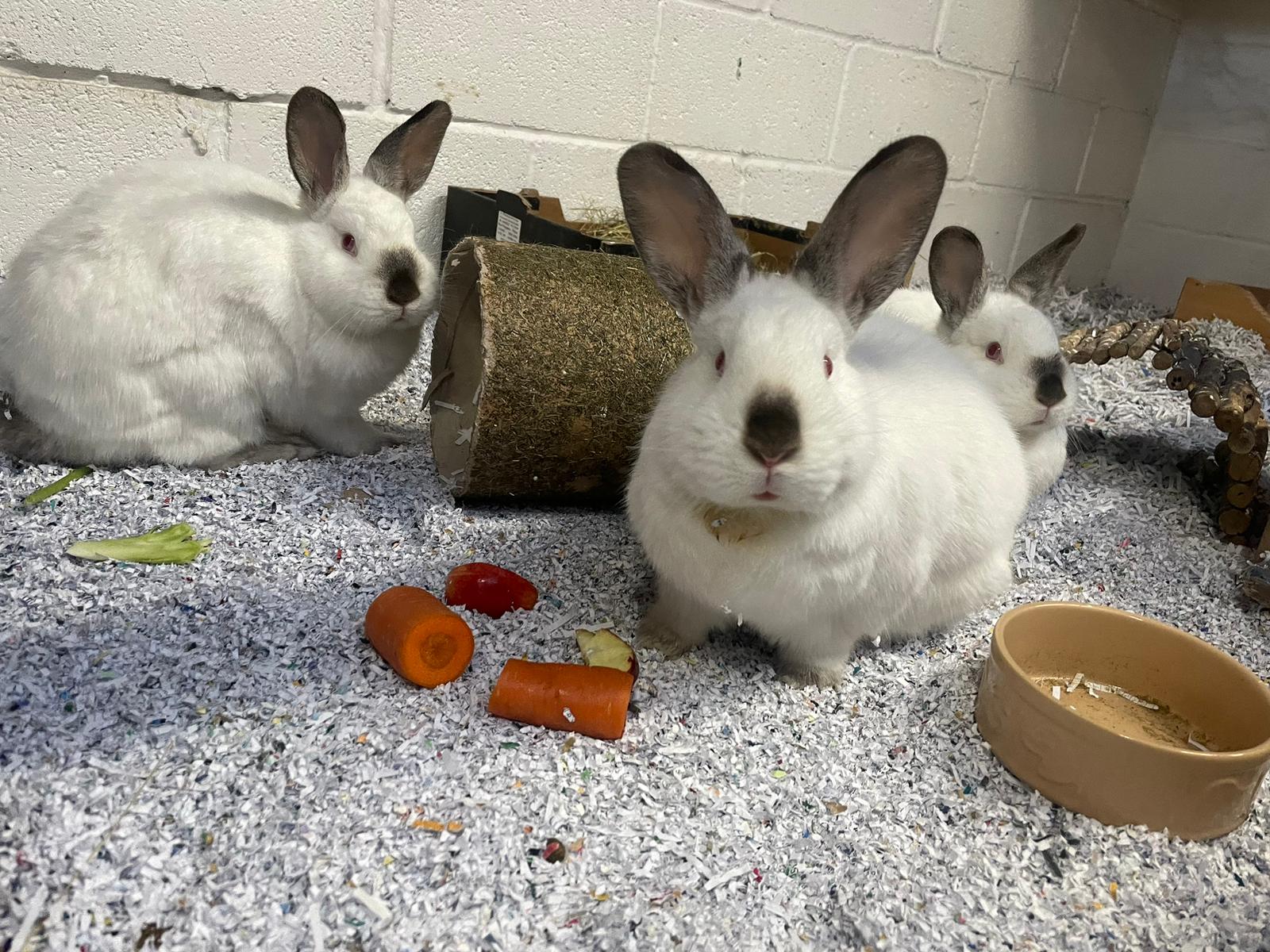
NEUTERING
There are more abandoned rabbits than all rescues can find places for. Rabbits are famous for how quickly they breed! A female can have four to eight babies every 30 days from February to late summer. Neutering removes the risk of unwanted pregnancies. It also removes the risk of womb infections and uterine cancer in females. Eliminates prostatic and testicular cancer in males. It can also help to litter train your rabbit and reduce aggressive behaviour, particularly in males.
Teds Story
Ted was found abandoned down the lane, by our Liverpool site. Luckily, a passing cyclist was able to catch Ted and bring him to us. On arrival, he was given a thorough health check and put into an isolation pen for a few days.
From day one staff had to be skilled and quick at dodging pee as Ted would spray urine at them, when they went to feed and clean him. He would spend the majority of his time pacing around his pen in an agitated way. We set up a camera to view his behaviour when staff were not in the room. However, this made no difference and Teds erratic behaviour continued. Our small animal team are very experienced in caring for rabbits and knew immediately that Ted needed to be neutered, with the hope that this would help calm him down.
Once Ted was neutered it took a few weeks but he began to become more relaxed and did stop spraying urine, and pacing. Ted now enjoys lots of attention from the team, and is extremely nosey. He loves following staff around when they are cleaning, to make sure that they are cleaning to his standards.
The difference in Ted from being neutered is amazing, and he is a completely different rabbit. He is now a very happy and calm boy, who loves nothing more than head scratches.
We suspect that Ted may have been dumped due to his stress behaviour. With an increase in rabbits being bought over the lockdown period we want to spread awareness of how neutering benefits yourselves and your rabbits lives! If you have a rabbit that is behaving this way, please neuter it before thinking of giving it up. What a difference the procedure has made to Ted’s life and we hope his story can benefit other rabbits too.
VACCINATIONS
It is vital that you keep up to date with your rabbit’s vaccinations. Myxomatosis (MYXO) and Viral Haemorrhagic disease (VHd) can both kill, with survival rates being as little as 1 – 5%. Many people believe their rabbits will not be affected by these terrible diseases if they are not mixing with other rabbits. The diseases however are spread by biting insects such as fleas, mosquito’s, or midge’s, and humans can also bring it back unknowingly if we have been in an area where wild buns are present and have the disease. ALL unvaccinated rabbits are at risk, wherever they are. If an unvaccinated rabbit is bitten by an insect carrying either one of these diseases the rabbit will likely become very ill and in most cases die. Please ensure your rabbit is vaccinated every 12 months. Your vet should also fully health check your rabbit at the time of vaccination thereby ensuring your bunny is both healthy and happy.
COMPANIONSHIP – Rabbit’s value companionship over food!
They are extremely sociable creatures and not having a companion leads to boredom and can cause stress. Rabbits also feel safer with their own kind. Rabbits should be neutered and bonded. Different neutered sexes tend to be the best fit, although some same-sex bonding can occur. Same sex bonding is more common in litter mates who have been neutered before the hormones kick in.
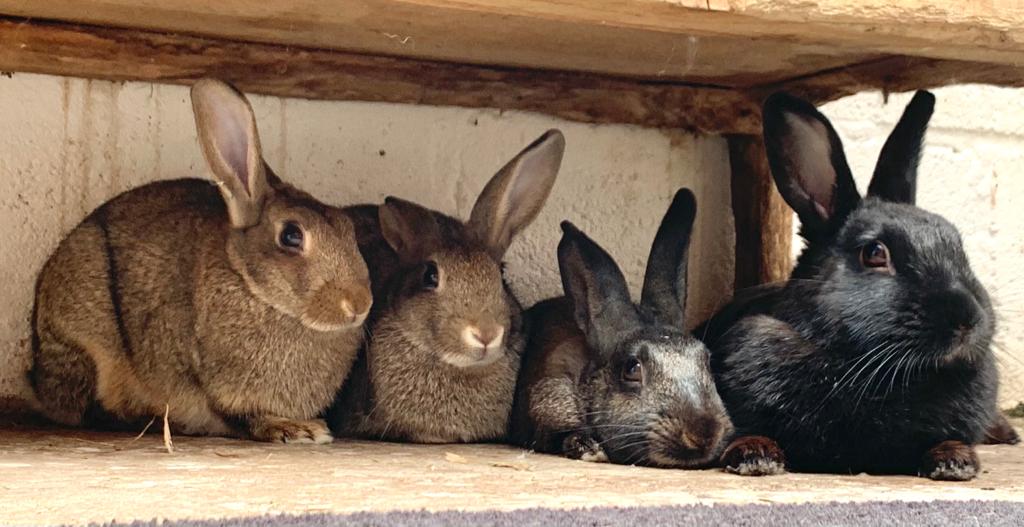
Donate Here
Lost & Found Pets

Merchandise
Exclusive merchandise available direct from the rescue. Don't miss out, follow the link to make your purchase today.


